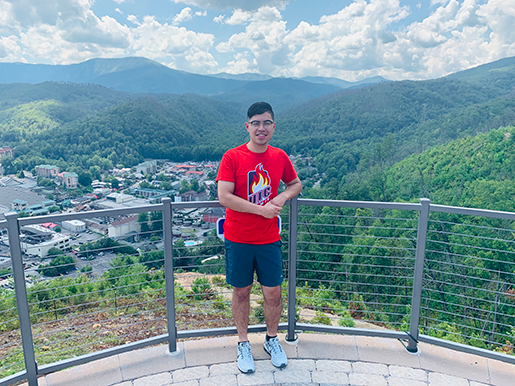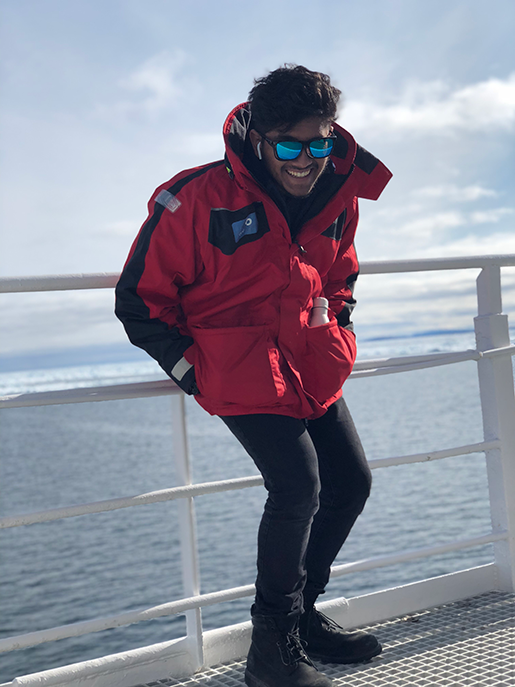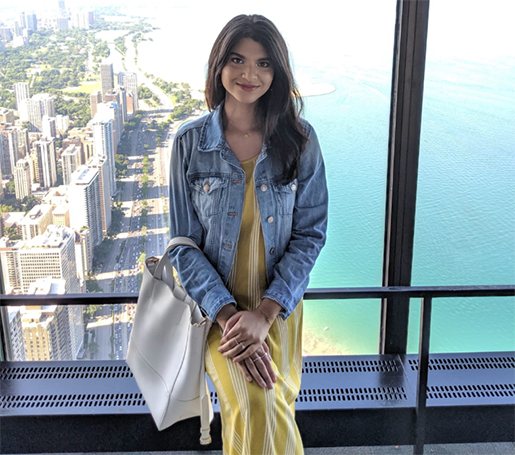Inside the Cadaver Lab, Part 3: What it's like to take an anatomy lab course
Posted on 12/5/19 by Laura Snider
Welcome back to our Inside the Cadaver Lab series, where we’ve been talking about all things cadaver lab! We’ve discussed the history of cadaver dissection and we’ve talked about lab courses from an instructor perspective, so now it’s time to hear about some students’ experiences.
We reached out to Isidro, Humair, Marta, and Hiba, undergraduate students from the University of Illinois at Chicago (UIC), and they were kind enough to tell us what it’s like to take an anatomy lab course and how using 3D technology helped them along the way.
Isidro
"...no cadaver showed each muscle the same, which made it even more important to understand general attachments and relationships for each we had to know."

I am a 4th year student and a Kinesiology major here at UIC on the Physical Therapy track, set to graduate in Fall 2020! Deciding to switch my major to Kinesiology my second year was one of my best decisions as it has helped me discover my passion and the route I wish to take in life.
The way it works here at UIC is that there is a separate cadaver dissection course that one can take after completing both A&P I and II. These students would work rigorously through the semester to ensure students currently taking A&P I and II would have proper learning resources as they take the course. I am currently taking the Cadaver Dissection course and the most important thing I learned so far from participating is a better understanding of the various structures of the human body. It is by no means easy, but the knowledge gained from dissecting a fresh cadaver to deeper underlying structures is invaluable.
For my first day of lab for A&P I, I had come in very nervous as I knew this course was going to be challenging, but overall it was a great experience! I had the chance to meet fellow students taking the course and got to see some of the prosections dissected by students in the cadaver dissection class, which I thought was super interesting, seeing structures firsthand. Prior to coming into the lab, I had watched most of the lecture videos for the week to help prepare and took necessary notes to ensure I came into lab ready to participate.
The most surprising thing I experienced in lab was just seeing firsthand how unique each human body can be when in the cadaver lab. When first taking this course, I thought that every structure would look as according to the dry models used in lab or from the internet, but I was wrong! Especially when it came to reviewing for the musculoskeletal system, no cadaver showed each muscle the same, which made it even more important to understand general attachments and relationships for each we had to know.
My favorite part of taking the lab course was having the opportunity to use multiple cadavers as a learning resource throughout two semesters of A&P. It is a privilege that not every student may have depending on where they took the course, so I always tried to appreciate the time spent in lab as I knew the resources I had would benefit me greatly being an aspiring physical therapist.
Even now that I have finished taking A&P I and II, Visible Body serves as a valuable resource for my other Kinesiology courses that include applied musculoskeletal anatomy. As I became accustomed to the lab format for A&P, Visible Body served as a good supplement for preparation so by the time I arrived to lab, I was really not learning anything new.
The 3D models made it a good resource to study as they provided accurate representations of the structures and were a good way to practice my knowledge in preparing for lab exams. The relevant information listed for each structure such as their function was also very helpful as it helped better understand the purpose of each relevant structure. It was also great to use the Visible Body application when in the cadaver labs, as it helped one ensure that they were understanding the structures correctly and identify certain structures that may not be easily seen in a cadaver.
My advice for future A&P lab students is:
- Consistency and coming to each lab session prepared and ready to engage.
- Take the utmost time spent in lab, making sure that you are understanding the structures and also their functions, without being afraid to ask questions to clarify.
- If you are working with a group of students, a really good study strategy is teaching each other, as it helps really solidify the material and helps clarify on what one still struggles on.
- Also taking the time to not just memorize how certain structures look and trying to find any relevant relationship that makes sense to the student is also another good way to help the material stick.
The lab portion of A&P can be super overwhelming at times with how much a student is expected to know, but making the effort to do a little bit of studying every day goes a long way to ensure success.
Humair
"In my opinion, Visible Body really helped me visually understand the content and I would even say using Visible Body is just as important as going to the lab."

I am currently in my fourth year here at the University of Illinois at Chicago (UIC). I am pursuing a dual-degree in biological sciences and in applied clinical psychology on a pre-medical track. My studying pattern is usually to understand functions and concepts rather than memorizing; however, Anatomy and Physiology is a type of class that requires a lot of memorizing and I was apprehensive, to say the least.
My first day of lab went well because I had reviewed the material before walking into it. I first prepared by understanding the content of what I was expected to know by the structure list and then I compared this knowledge with models and Visible Body. I made sure I had seen the structures beforehand on Visible Body in order to have a basic understanding and visual.
Students in our lab course do not dissect the cadavers, but we are able to see dissected cadavers. During the ligament and joint unit, cadavers helped us to see the attachment points and the ligaments in a tangible form.
The most unexpected thing I have experienced in the lab was being able to see all the different structures such as the ligaments on the cadavers. It was very interesting to see the structures learned through Visible Body and class in person.
My favorite aspect of taking a lab course is the hands-on part of it. It is always useful to see the information with a hands-on approach. In my opinion, Visible Body really helped me visually understand the content and I would even say using Visible Body is just as important as going to the lab.
Visible Body’s 3D anatomy resources made a really big change in my ability to do well in this class. The visual and detailed structures make it very easy to learn Anatomy & Physiology. During the bone and joint unit, Visible Body aided my knowledge and corrected me when I misunderstood or misinterpreted information. Visible Body allowed me to practice and identify the parts of the bones, parts of epidermis and dermis, and various joints. This tool was crucial in my ability to learn the information and to do well on the exam without a doubt.
My advice to future Anatomy & Physiology students is practice, practice, and more practice. Identify structures every day and don’t do it all at once. It is vital to take enough time to learn structures and to review a few structures every day. Use tools like Visible Body and look up images to cement the information.
Marta
"The most surprising thing that I experienced in lab is that I was able to go home and study on a model from my phone, laptop, or tablet. I could be on my way to school by train and study all the bones just by touch. "
I am a pre-med student majoring in Biological Sciences at the University of Illinois at Chicago.
When I first came into my A&P lab, I was a bit overwhelmed as to how I would not be able to see the actual skeleton and apply my knowledge with hands-on experience. Before the lab, I went over our structures list and defined all the structures using my Anatomy Atlas book.
So far I think that my favorite part about taking a lab course in Anatomy is that we get to see models of our structures and then go into the wet lab and view those same structures on cadavers. The most important thing that I learned about looking at cadavers is that there are many more structures on a real body than on a model.
Visible Body helped me look at the body in a different perspective and it definitely helped that I could break the entire body down piece by piece to look at every structure individually. The most surprising thing that I experienced in lab is that I was able to go home and study on a model from my phone, laptop, or tablet. I could be on my way to school by train and study all the bones just by touch.
As advice, I suggest you download the app on your phone and iPad and carry it around and look at all the different structures individually to learn with more benefit.
Hiba
"Anyone who has had the opportunity to learn off of cadavers can easily say that they are the most amazing experience you encounter."

I am currently a Senior at UIC studying Kinesiology with a concentration in Exercise Science, and a goal of Physical Therapy. I took Anatomy and Physiology my sophomore year and loved it so much that I decided to enroll in Cadaver Dissection, Undergraduate Teaching for A&P, and become a tutor at the Academic Support and Achievement Program (ASAP).
My first day of lab was the familiar overwhelming yet excited feeling I get on the first day of classes. I remember after a brief introduction from my TA we jumped straight into the material. I purposely made my schedule so I would have lab right after discussion so I had some background before heading in.
My favorite aspect of taking a lab course is the cadavers! Anyone who has had the opportunity to learn off of cadavers can easily say that they are the most amazing experience you encounter. The amount of detail you learn from them on how structures look, feel, and interact with each other is unexpected. Each body is different and the experiences you go through are reflected within.
I used Visible Body when taking Cadaver Dissection since it was unavailable to me when taking A&P. I used it to view structures and their orientation when doing specific dissections. I also used it to teach A&P students as a tutor and Undergraduate Teaching Assistant. Being able to see structures in situ and manipulate the surroundings to gain a better understanding of "structure equals function" was helpful to students especially when the cadavers were not accessible.
My advice to future A&P students is:
- Review beforehand, even by simply looking up pictures of the structures.
- Take advantage of your time with other students; form a group and take turns teaching each other.
- If there is something you are struggling with, then ask for help and find a way to make things meaningful to you.
We would like to thank Isidro, Humair, Marta, and Hiba, and we wish them all the best as they continue their studies!
Be sure to subscribe to the Visible Body Blog for more anatomy awesomeness!
Are you an instructor? We have award-winning 3D products and resources for your anatomy and physiology course! Learn more here.



